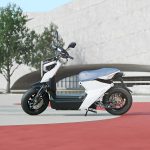Electric motorcycles are redefining the future of two-wheeled mobility, blending sustainability with cutting-edge technology. As cities push toward cleaner transportation and riders seek more intelligent machines, electric bikes powered by artificial intelligence are becoming a symbol of progress.
- The Shift Toward Electric Mobility
- AI’s Role in Enhancing Performance
- Smart Connectivity and Real-Time Monitoring
- Sustainability and Green Innovation
- Battery Technology and Range Improvements
- Safety Innovations and Predictive Systems
- Economic Benefits and Cost Efficiency
- The Growing Role of Smart Infrastructure
- FAQs
- How do AI systems enhance electric motorcycle performance?
- Are electric motorcycles cheaper to maintain?
- What are the main challenges for electric motorcycle adoption?
- Can AI make electric motorcycles safer?
- How far can modern electric motorcycles travel?
- Conclusion
These next-generation motorcycles are not just reducing emissions—they are transforming how riders interact with their bikes, how performance is managed, and how the entire experience of motorcycling feels in a connected, digital world.
The Shift Toward Electric Mobility
Over the past decade, the motorcycle industry has seen a steady shift toward electrification. Manufacturers are responding to global climate goals and consumer demand for cleaner alternatives to traditional fuel-powered bikes. Electric motorcycles eliminate exhaust emissions and significantly reduce noise pollution, making them ideal for modern cities.
Governments across the globe are offering incentives for electric vehicle (EV) adoption, including subsidies and tax reductions. These measures, combined with advances in battery technology, have made electric motorcycles more affordable and practical for everyday riders.
AI’s Role in Enhancing Performance
Artificial intelligence is taking electric motorcycles to the next level. By analyzing data from sensors, GPS, and rider inputs, AI systems optimize performance in real time. They can adjust power distribution, traction control, and regenerative braking to match riding conditions and habits.
For example, if a rider frequently takes sharp turns, the AI can adapt the bike’s torque response to improve stability. Similarly, it can fine-tune the battery’s energy output for better efficiency or longer range. The result is a ride that feels smoother, safer, and more responsive than ever before.
Smart Connectivity and Real-Time Monitoring
Connectivity is a key element in the evolution of electric motorcycles. Through mobile apps and cloud platforms, riders can now access real-time information about battery life, motor temperature, maintenance schedules, and even riding performance.
AI-driven diagnostics can detect potential issues before they become serious. Riders receive alerts for maintenance or part replacements, reducing downtime and increasing safety. This connected ecosystem not only improves reliability but also creates a personalized experience tailored to individual riding habits.
Sustainability and Green Innovation
Electric motorcycles are at the forefront of sustainable transportation. With zero tailpipe emissions and high energy efficiency, they play a crucial role in reducing urban air pollution. Many manufacturers are also focusing on eco-friendly materials and recyclable batteries to minimize the overall environmental footprint.
Charging infrastructure is rapidly expanding, with more fast-charging stations being installed worldwide. Some bikes now offer swappable battery systems, allowing riders to replace depleted batteries in minutes instead of waiting for a full charge. These innovations are making electric motorcycles more convenient and accessible.
Battery Technology and Range Improvements
Battery performance is one of the biggest factors influencing the success of electric motorcycles. Recent advances in lithium-ion and solid-state batteries have led to greater energy density, faster charging times, and longer lifespans.
Modern electric motorcycles can travel up to 200 miles on a single charge, depending on conditions and riding style. AI helps further by learning from the rider’s behavior, predicting energy consumption, and adjusting performance to maximize range. This intelligent energy management system ensures riders get the most from every charge.
Safety Innovations and Predictive Systems
AI isn’t only improving performance—it’s also saving lives. Advanced driver-assistance systems (ADAS) are being integrated into electric motorcycles, providing features such as collision warnings, blind-spot detection, and adaptive cruise control.
AI algorithms analyze traffic data and road conditions in real time, alerting riders to potential hazards before they occur. Combined with features like smart helmets and heads-up displays, these innovations are creating a new standard for motorcycle safety in the digital era.
Economic Benefits and Cost Efficiency
While the initial cost of electric motorcycles can be higher than traditional models, the long-term savings are substantial. Electricity is cheaper than gasoline, and maintenance costs are significantly lower since electric motors have fewer moving parts.
AI contributes by ensuring optimal energy use and predicting when maintenance is needed, reducing unexpected breakdowns. Over time, this makes electric motorcycles a cost-effective investment for daily commuting and long-distance riding alike.
The Growing Role of Smart Infrastructure
As more cities adopt smart traffic systems, electric motorcycles equipped with IoT and AI are becoming part of a connected ecosystem. Traffic lights, road sensors, and navigation apps communicate with bikes to optimize routes and minimize delays.
This seamless integration allows riders to enjoy smoother journeys while contributing to reduced congestion and emissions. In the near future, electric motorcycles could even synchronize with charging stations or maintenance hubs automatically, making urban mobility fully intelligent.
FAQs
How do AI systems enhance electric motorcycle performance?
AI systems analyze data from sensors and rider input to optimize power, battery usage, and safety features. This results in smoother acceleration, longer range, and better traction control.
Are electric motorcycles cheaper to maintain?
Yes. Electric motorcycles have fewer mechanical parts and don’t require oil changes or complex engine maintenance, making them more affordable to operate over time.
What are the main challenges for electric motorcycle adoption?
The biggest challenges are limited charging infrastructure, battery costs, and range anxiety. However, rapid technological progress is addressing these issues each year.
Can AI make electric motorcycles safer?
Absolutely. AI-powered systems provide real-time hazard alerts, collision avoidance, and adaptive riding controls that enhance rider safety and awareness on the road.
How far can modern electric motorcycles travel?
Depending on the model and riding style, many electric motorcycles can achieve between 100 to 200 miles per charge, with ongoing improvements pushing that range even higher.
Conclusion
Electric motorcycles represent a bold leap into the future of transportation, combining sustainability with intelligence. As AI continues to evolve, riders can expect machines that adapt to their habits, improve safety, and offer a personalized riding experience unlike anything before.
The combination of electric power and artificial intelligence is setting new standards for performance, efficiency, and environmental responsibility. For riders and cities alike, this transformation marks the beginning of a smarter, cleaner, and more connected motorcycling era.







